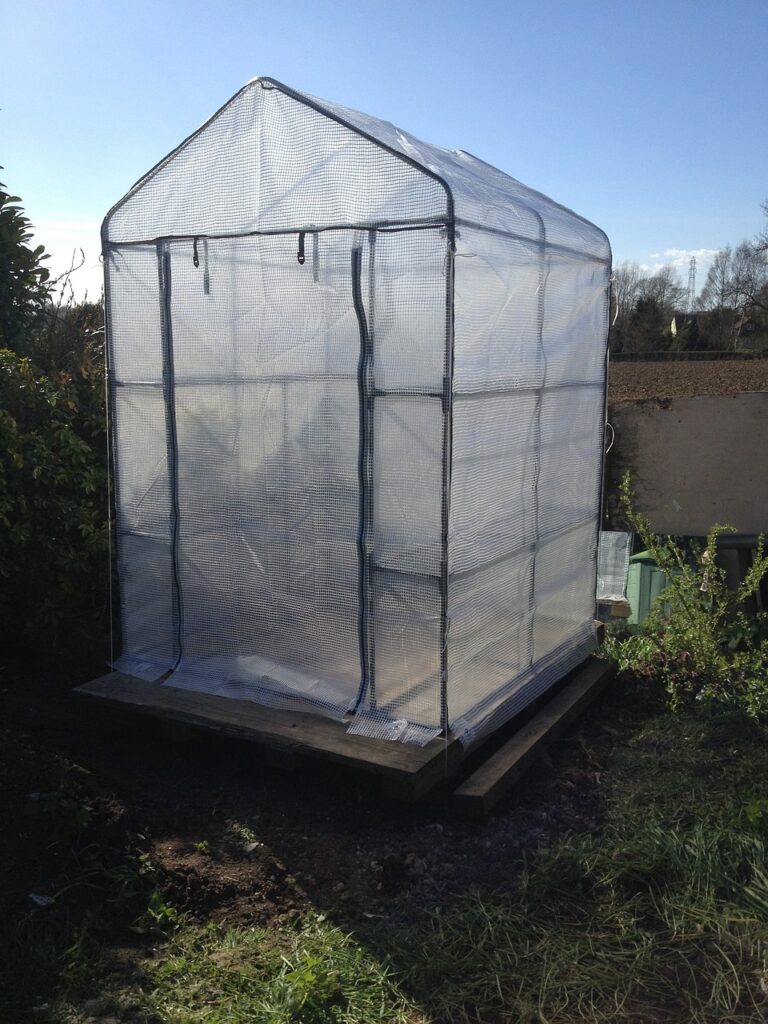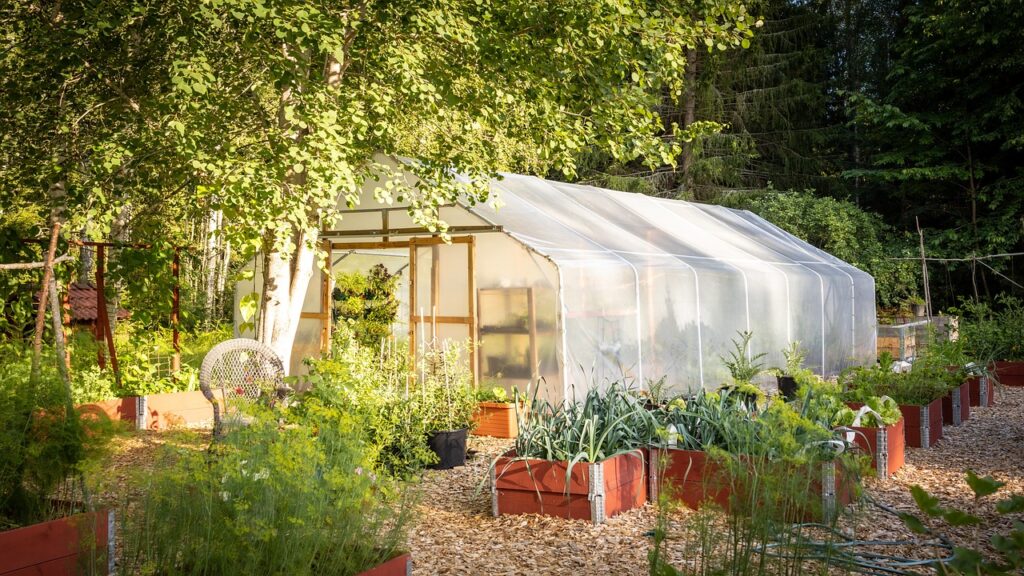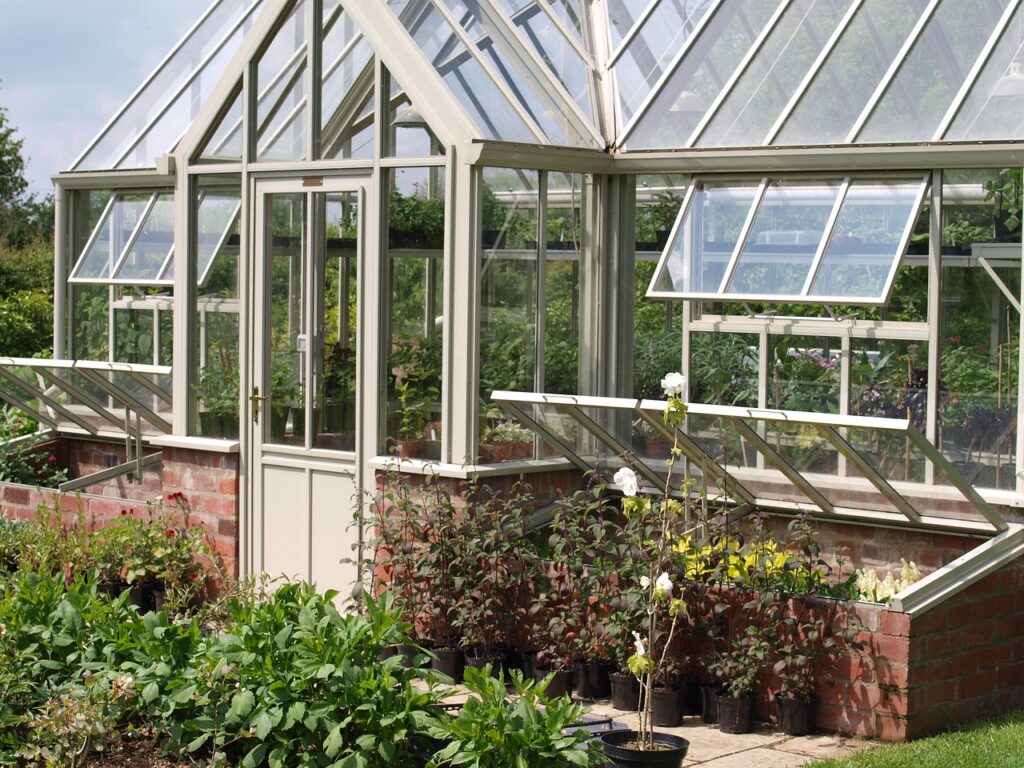As a greenhouse owner, you recognize the importance of maintaining a consistent and ideal temperature inside your structure called the “heart of the greenhouse.” The temperature is essential to your plant’s morphophysiological growth requirement. Therefore, investing in a heating system to provide your plants with optimal growing conditions is essential to support your gardening venture. There are many types of greenhouse heating systems. However, choosing the right heating method from all the available options, whether renewable energy or store-bought models, can be daunting. We’ll discuss how to heat a greenhouse, including system options, safety measures, proper heat distribution, and more. Let’s help find you the best greenhouse heaters for your needs.

As an Amazon and ebay Affiliate we may earn a commission off any purchases made through our links. This won’t affect the price you pay.
Energy-Efficient Heating Options for Greenhouses
When selecting a heating system for your greenhouse, you must consider energy conservation. Not all of us will require a commercial greenhouse heater. Renewable energy – eco-friendly systems is the way to go! Here are several energy-efficient heating options to choose from:
Radiant Heating Systems
Radiant heating systems are another popular choice for greenhouse owners and are known for their high level of efficiency and effectiveness. These systems use infrared radiation to heat the surrounding environment in the greenhouse. Radiant heating works on the principle that objects absorb heat and then release it into the surrounding atmosphere, which makes them an excellent choice for greenhouses.

The radiation emitted by these heating systems is converted into heat by the plants, water, and soil, which helps keep them warm and promote healthy growth. The heat produced by radiant heating systems is also distributed evenly, which is essential in keeping the entire greenhouse at a uniform temperature.
Radiant heating systems are one of the most efficient heating methods available on the market. They heat the plants directly without the need to warm up the air in the greenhouse, which reduces heat loss. In addition, radiant heating systems are available in multiple varieties and are incredibly versatile, allowing for heating in specific areas of the greenhouse.

Another benefit of radiant heating systems is that they are relatively low maintenance and do not require any significant installation procedures. These systems are easy to install and operate, making them an excellent choice for greenhouse owners who are looking for an effective and efficient heating solution.
However, radiant heating systems do have certain limitations. They are usually only suitable for smaller greenhouses, and larger greenhouse owners may need to install additional heating systems to ensure adequate heating in all areas. Additionally, these systems may not be suitable for plants that are sensitive to overheating.
Radiant heating systems are an excellent option for greenhouse owners who are looking for an efficient and effective heating system. They are versatile, energy-efficient, easy to install, and require low maintenance. Before choosing a radiant heating system, it’s important to consider the size of your greenhouse and the specific heating needs of your plants.
Heat Pumps
Heat pumps are a popular and energy-efficient option for heating greenhouses. They use electricity to extract heat from the surrounding air or ground and transfer it into the greenhouse. Heat pumps work by using a refrigerant that absorbs heat from the environment and then compresses it to release that heat inside the greenhouse.
Heat pumps have the advantage of energy efficiency. They utilize the surrounding environment’s natural heat and transfer it into the greenhouse, making them a highly efficient source of heat. In addition, heat pumps can also function as air conditioning units, providing both heating and cooling capabilities.
Heat pumps are also environmentally friendly, as they do not burn fuel in the heating process. This makes them a popular choice among greenhouse owners who prioritize sustainability and reduce their carbon footprint.
When selecting a heat pump for your greenhouse, it’s important to consider the size of your greenhouse and your specific heating needs. Heat pumps work best in milder climates, where the temperature does not fluctuate dramatically. They are suitable as small heating systems for greenhouses and may require the installation of multiple units if your greenhouse is bigger.

Heat pumps are an excellent option for greenhouse owners seeking an efficient and environmentally friendly route to a heated greenhouse. They utilize the natural heat of the surrounding environment and transfer it into the greenhouse, reducing energy costs and ensuring sustainable greenhouse operations. With the right size and installation, heat pumps can keep your greenhouse warm during the colder months and help your plants grow healthily and thrive.
Solar Greenhouse Heating Systems
Solar greenhouse heating systems are gaining popularity due to the increasing demand for eco-friendly and sustainable greenhouse practices. These systems harness energy from the sun, which can be used when heating a greenhouse during colder months. A solar greenhouse heater is a great choice for those looking to reduce their carbon footprint and support renewable and more natural energy sources.
Solar heating systems work by using solar panels that capture and convert the sun’s energy into heat. This heat is then transferred through a set of pipes and to a distribution unit inside the greenhouse. Solar greenhouse systems also incorporate a thermal system to store excess heat harvested during the day, making it available at night when the greenhouse requires heat.
One of the significant advantages of solar greenhouse heating systems is that they’re entirely reliant on the sun’s energy, making them a cost-effective and sustainable heating option. These systems allow greenhouse owners to operate independently of utility electricity and reduce their carbon footprint while promoting renewable energy.

Another benefit of a solar greenhouse heater is the low maintenance costs. They require little to no maintenance beyond occasional cleaning of the solar panels. This helps minimize maintenance costs and makes them a long-term cost-effective heating solution.
However, solar greenhouse heating systems also have limitations. Their effectiveness depends on the amount of sunlight they receive, which can be significantly reduced during cloudy days or when there is heavy snowfall. This can make these systems less effective in places with long and harsh winters, or when there are many cloudy days in a row.
Solar greenhouse heating systems are a sustainable and eco-friendly option that utilizes free and natural energy sources. While they may not be suitable for all greenhouse owners, they offer a cost-effective and low-maintenance solution for small to medium-sized greenhouses. Solar heating systems provide an excellent way to promote eco-friendly greenhouse operations while reducing energy costs and promoting renewable energy.
Store-Bought Heating Systems for Greenhouses
Store-bought greenhouse heating systems are ideal for first-time greenhouse owners due to their ease of installation and convenience in fitting different greenhouse sizes. Here are some of the most popular types of store-bought heating systems for greenhouses:
Electric Heaters
Electric heaters are ideal for smaller greenhouse owners. They are easy to install, energy-efficient, and can be conveniently operated without generating any noise.
Propane Heaters
Propane heaters are a popular choice for larger greenhouse owners due to their efficient heating of large spaces and ability to function during power outages. These heaters are available in different sizes depending on the greenhouse size, requiring fuel in the form of propane gas to generate the heat.
Natural Gas Heaters
Natural gas heaters are the most energy-efficient and environmentally friendly among the store-bought choices. These are especially suitable for greenhouse owners who are pursuing a more sustainable approach to their gardening.
Safely Install Greenhouse Heating Systems
Safety should always be a top priority when installing a heating system. Here are some practical tips to ensure that your greenhouse heating system installation is safe and successful.
Planning
Thorough planning is crucial when installing a heating system in your greenhouse. Plan carefully and acquire the necessary skills and knowledge to install it efficiently and safely. Consider the heating system design, greenhouse size, and plant’s heating requirements.
Purchase Reliable Heating Systems
When choosing your greenhouse heating system, select an efficient heating system that is both energy-efficient and safe. Consider factors like cost, ease of installation and maintenance, features, and brand reliability.

Hire a Professional
Unless you have the necessary skills, hire a professional to install the heating system. Hiring an installation expert prevents hazardous mistakes during installation and safeguards your investment and the safety of your plants.
Maintenance
Regular maintenance is essential to keep your heating system working efficiently and prevent any potential hazards. Hire a professional technician to conduct routine maintenance or learn to maintain your systems using manufacturer instructions.
Keep Flammable Materials Away From Heating System
Keep any flammable materials away from the heating system. This removes the risk of any accidental fire hazards from causing burns to the plants.
Heat Distribution and Heat Loss in Greenhouses
The key to proper greenhouse heating is efficient heat distribution. When the heat is not distributed evenly, there is the risk of creating hot spots instead of a uniformly warm environment for plant growth. Heat loss should also be minimized as it could increase the operating cost of your greenhouse. Consider the following:
• Fans: Fans are effective in distributing both cold and hot air throughout the greenhouse. They create a steady and uniform warm environment, promoting even growth for your plants.
• Insulation: Insulation is essential to retain the heat and regulate temperature inside the greenhouse, especially during the cold winter months.
Electric Heating vs. Gas Heating for Greenhouses
Choosing the right heating system that suits your greenhouse heating needs can be challenging. The primary options available are electric or gas heating systems. Here’s a brief breakdown of their differences:

Electric Heating
Electric heating systems generate warmth by converting electric energy into heat energy using electric resistive coils. The coils are responsible for producing heat by heating the air around it. The air is then circulated by a fan, which distributes the heat throughout the greenhouse. The electrical current provides an even and controlled temperature throughout the structure.
Types of electric heating systems for greenhouses
Here are some common types of electric heating systems for greenhouses:
1. Convection heating
Convection heaters use the process of convection, where warm air rises while cold air falls, to heat the greenhouse. They are known for their energy efficiency, as they use less energy to heat the structure while maintaining a steady temperature.
2. Radiant heating
Radiant heating systems use infrared radiation to warm up plants and the surrounding environment. They produce heat similar to the way the sun warms the earth. Radiant heating systems tend to work best in smaller greenhouses.
3. Fan-forced heaters
Fan-forced systems use a fan to circulate heated air throughout the greenhouse. These systems work best at maintaining a consistent temperature throughout the greenhouse.

Benefits of electric heating systems for greenhouses
1. Affordability
Electric heating systems are affordable compared to other heating systems, such as propane and natural gas heaters. They are much cheaper to purchase and install, which makes them ideal for greenhouse owners on a budget.
2. Safety
Electric heating systems do not emit harmful gases or smoke, making them safer for greenhouse owners and their plants. Additionally, electric heaters have automatic shut-off features, which helps prevent any hazards caused by overheating.
3. Low maintenance
Electric heating systems require low maintenance as they do not use any moving parts. Unlike other heating systems that require regular maintenance, electric heaters can operate for years without the need for maintenance.
4. Easy installation
Installing electric heating systems is a straightforward process that requires no complex plumbing or heating systems. This makes them an easy choice for greenhouse owners who want to set up their heating systems quickly.
5. Energy efficiency
Electric heating systems are energy-efficient, as they do not burn any fuel. They convert electricity into heat energy, which results in lower energy bills in comparison to other heating systems.
6. Environmentally friendly
Electric heating systems are eco-friendly as they do not use fossil fuels. By installing an electric heating system, you reduce your carbon footprint and contribute towards protecting the environment.

Gas Heating
Gas heating systems are a popular option for greenhouse owners who require larger heating solutions. These systems can be powered by natural gas, liquid propane, or oil. Gas heaters can be used as a stand-alone unit or to complement an existing heating system. They are best suited for large greenhouses where the heat demand is high, and maintaining consistent temperatures is crucial.
One of the significant advantages of gas heating systems is their ability to produce high amounts of heat. They typically have a heating capacity of up to 130,000 BTUs, which is three times higher than some electric heaters’ capacity. These systems can be used to provide heat even during power outages, making them a reliable heating option.
Another significant advantage of gas heating systems is their fuel efficiency. These systems produce more heat per unit of fuel compared to electric heaters, which makes them a cost-effective option in the long run. Additionally, gas heating systems require low maintenance compared to electric heaters, making them a suitable option for greenhouse owners who prefer a hands-off approach to heating maintenance.
When using gas heating systems, it’s essential to utilize safety precautions. The heaters should be installed appropriately by a professional to avoid gas leakage, which can lead to fire hazards. It’s also crucial to monitor the heating system’s carbon monoxide levels, as gas heaters can produce this poisonous gas if not well-maintained or if installed incorrectly.
Gas heating systems are a popular option for greenhouse owners who require a large capacity heating solution. These systems offer high heat production and fuel efficiency, making them a cost-effective option in the long run. Proper installation, maintenance, and monitoring of carbon monoxide levels are crucial to ensure a safe heating solution for greenhouse owners.
Boiler Heating Systems for Greenhouses
Boiler heating systems circulate heated water through pipes to radiators installed throughout the greenhouse. The radiators release heat, promoting warm circulation around the plants. Heating the water in the boiler could be powered by oil, natural gas, or propane. Boiler heating systems are energy-efficient and appropriate for larger greenhouses.
 Geothermal Heating Systems for Greenhouses
Geothermal Heating Systems for Greenhouses
Geothermal heating systems exploit the heat from the earth to warm up greenhouses. The heating system functions by absorbing heat from the ground using underground loops filled with antifreeze. The antifreeze carries heat to a unit that heats up the greenhouse air circulation. Geothermal heating systems are incredibly efficient and save you significant amounts of money on energy costs in the long run.

Choosing an appropriate greenhouse heating system is crucial to the success and optimal growth of your plants. Greenhouse owners can make informed decisions based on their energy goals, investment flexibility, heating requirements, and environmental concerns. Furthermore, greenhouse owners must consider the safety and proper installation procedures and distribution techniques for optimal results. We hope that this ultimate guide for heating systems for greenhouses has enabled you to choose the appropriate heating system and set up efficient heat distribution practices to support your greenhouse gardening venture.

As an Amazon and ebay Affiliate we may earn a commission off any purchases made through our links. This won’t affect the price you pay.

